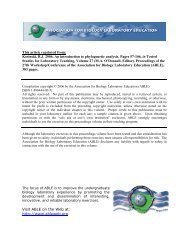Using Chives to Study Meiosis - Association for Biology Laboratory ...
Using Chives to Study Meiosis - Association for Biology Laboratory ...
Using Chives to Study Meiosis - Association for Biology Laboratory ...
You also want an ePaper? Increase the reach of your titles
YUMPU automatically turns print PDFs into web optimized ePapers that Google loves.
20 <strong>Meiosis</strong><br />
4. Once the excess stain has been blotted away and the cover glass appears not <strong>to</strong> the floating<br />
freely, make detailed examination of the meiotic figures with the oil immersion lens.<br />
It may be desirable <strong>to</strong> preserve some slides <strong>for</strong> future reference. Temporary preservation can be<br />
accomplished a number of ways. One useful technique is <strong>to</strong> apply a coating of <strong>to</strong>uch-up enamel<br />
around the edges of the cover glass. Various fingernail polishes, waxes, and other ringing<br />
compounds may also be used, including KARO corn syrup! Slides treated carefully this way will<br />
last 1 week or more be<strong>for</strong>e eventually drying out. Extreme caution should be used if slides treated<br />
this way are used <strong>for</strong> oil immersion microscopy!<br />
Observations<br />
A wide range of cell types may be observed. Some non-meiotic cells will be seen, especially if<br />
the “quick and dirty” method is used. Non-meiotic cells will resemble onion root tip cells or other<br />
undifferentiated cells. Cells undergoing meiosis will be larger than the cells of the supportive tissue<br />
and will contain prominent nuclei or obvious chromosomes. If very small buds are used, premeiotic<br />
mi<strong>to</strong>tic figures will be observed in what will become microspore mother cells. <strong>Meiosis</strong> is<br />
typically divided in<strong>to</strong> the following stages:<br />
<strong>Meiosis</strong> I<br />
Lep<strong>to</strong>tene: Chromosomes become visible as threads. Keep in mind that what appears <strong>to</strong> be a single<br />
thread is actually two chromatids because replication <strong>to</strong>ok place in the interphase prior <strong>to</strong> meiosis.<br />
It may be necessary <strong>to</strong> <strong>for</strong>ce the cover glass down a bit in order <strong>to</strong> make individual chromosomes<br />
visible.<br />
Zygotene: Pairing of homologous chromosomes occurs. The chromosomes appear thicker and less numerous<br />
because pairing occurs. Again, it may be necessary <strong>to</strong> apply some pressure <strong>to</strong> the cover glass in order <strong>to</strong> observe<br />
the paired nature of the chromosomes.<br />
Pachytene: The chromosomes become shorter and thicker. The amount of chromosomal material appears <strong>to</strong> be<br />
considerably less because the chromosomes have become much shorter. The fact that the chromosomes are paired<br />
should be obvious.<br />
Diplotene: The characteristic feature of diplotene is the presence of chiasmata. The chromosomes are also shorter<br />
than in pachytene.<br />
Diakinesis: Repulsion of the centromeres and terminalization of the chiasmata mark this stage. The<br />
chromosomes are very short and thick, but they have not yet lined up in a characteristic metaphase figure.<br />
Metaphase I: The chromosomes are lined up on the spindle. The staining procedure used here does not reveal the<br />
spindle. A polar view of metaphase I reveals the chromosomes <strong>to</strong> be organized at one plane in the cell. A nonpolar<br />
view of metaphase I makes it appear as though the chromosomes are lined up across the middle of the cell.<br />
Anaphase I: Separation of the paired homologs. It should be noted that the chromosomes now appear thinner.<br />
Comparisons with metaphase I make it obvious there has been a halving of the genetic material with half going <strong>to</strong><br />
each pole. Early and late stages of anaphase I will be seen.
















